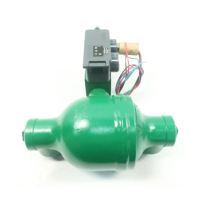Instruction Manual
D200119X012
2100 and 2100E Liquid Level Switches
June 2017
10
Maintenance
Switch parts are subject to normal wear and must be inspected and replaced when necessary. The frequency of
inspection and replacement depends on the severity of service conditions.
Refer to figure 5 for maintenance of the 2100 switch and figure 6 for maintenance of the 2100E switch.
WARNING
Always wear protective clothing, gloves, and eyewear when performing any maintenance procedures to avoid personal
injury.
The displacer is a sealed container inside the cage. A displacer penetrated by process fluid may retain pressure or hazardous
fluid for an extended period. Such a displacer may contain pressure as a result of being in a pressurized vessel, or it may
contain fluid that becomes pressurized due to changes in temperature and/or it may contain fluid that is hazardous or
flammable. The sudden release of pressure, contact with hazardous fluid, fire, or explosion resulting in personal injury can
occur if a displacer that is retaining pressure or process fluid is punctured or subjected to heat. Handle the cage (with
displacer inside) with care in removing, storing, or disposing, taking into consideration the characteristics of the process
fluid.
To avoid personal injury and damage to the process system caused by the sudden release of pressure, contact with
hazardous fluid, fire, or explosion, isolate and drain the displacer cage.
For the 2100, shut off and bleed supply pressure from the switch before attempting any maintenance procedures. For the
2100E, shut off the power to the electric switch assembly before attempting any maintenance procedures.
Check with your process or safety engineer for any additional measures that must be taken to protect against process
media.
The displacer cage should be flushed periodically to remove deposits or sludge that may affect proper operation. The
frequency of flushing depends on the nature of the process liquid. Before flushing, close the isolating valves and drain
the cage. Flush from one of the top connections to one of the bottom connections. Also, remove the pipe plug (key 2)
or the bushing and sight window (keys 4 and 5), and flush from a top connection through the pipe plug or sight
window connection.
Inspect the vent or vent screen (key 23) or vent line periodically to ensure that the vent or vent line is not plugged.
Table 3 lists various 2100 switch problems and possible solutions for them. The table is valid for either high‐level or
low‐level switching action and for any supply pressure range. If a correction step requires replacement of worn or
damaged parts, refer to the appropriate maintenance procedure in this manual for disassembly and reassembly
instructions.
2100E switch problems are solved through common electrical troubleshooting procedures. Fault 4 of table 3 is also
pertinent for the 2100E switch.
Operational Test (2100 and 2100E)
Establish a periodic operational test of the switch to ensure that:
a. the torque tube is functioning as a continuous spring element;
b. there is an absence of excessive friction;
c. there is no contact with the mechanical stops, and;
d. the torque tube is still effectively transmitting force and motion to the 2100 flapper and clamp assembly, or to
the 2100E switch arm assembly.

